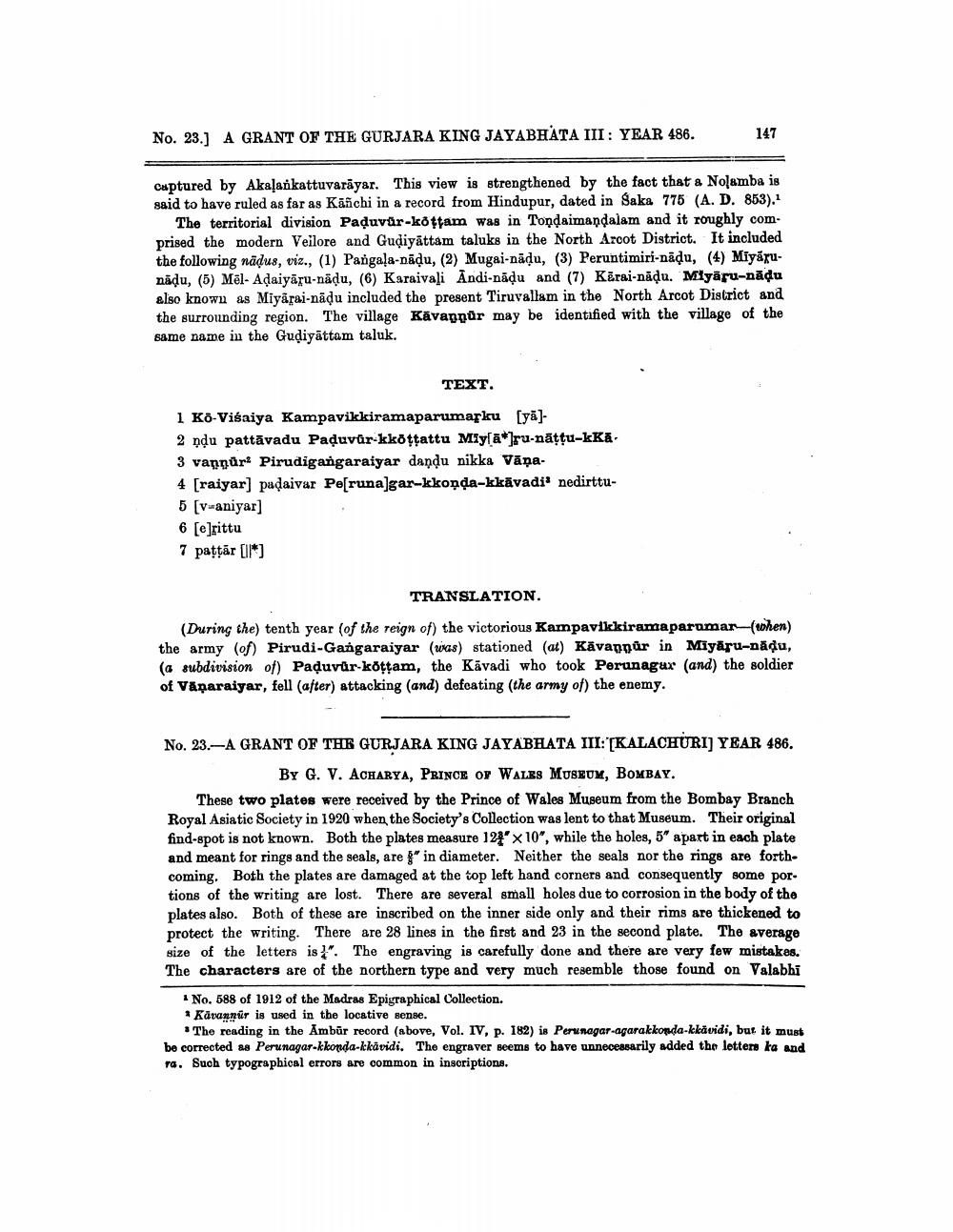________________
No. 23.) A GRANT OF THE GURJARA KING JAYABHATA III: YEAR 486.
147
Captured by Akalankattuvariyar. This view is strengthened by the fact that a Nolamba is said to have ruled as far as Käfichi in a record from Hindupur, dated in Saka 776 (A. D. 853).
The territorial division Paduvür-kottam was in Tondaimandalam and it roughly comprised the modern Veilore and Gudiyattam taluks in the North Arcot District. It included the following nädus, viz., (1) Pangala-nādu, (2) Mugai-nādu, (3) Peruntimiri-nadu, (4) Miyarunādu, (5) Mēl- Adaiyāru-nädu, (6) Karaivali Andi-nādu and (7) Kārai-nădu. Mlyäru-nādu also known as Miyårai-nādu included the present Tiruvallam in the North Arcot District and the surrounding region. The village Kävapnür may be identified with the village of the same name in the Gudiyattam taluk.
TEXT.
1 KO-Visaiya Kampavikkiramaparumasku (yā)2 ņdu pattāvadu Paduvür-kkottattu Miy[Ā*]ru-năttu-kKa. 3 vappur? Pirudigangaraiyar dandu nikka Vāņa4 [raiyar) padaivar Pe[runa]gar-kkonda-kkāvadit nedirttu5 [v=aniyar] 6 [e]rittu 7 patřār [Il*]
TRANSLATION
(During the) tenth year (of the reign of the victorious Kampavikkiramaparumar-(when) the army (of) Pirudi-Gangaraiyar (as) stationed (at) Kävangur in Miyasu-nadu, (a subdivision of Paduvür-kottam, the Kāvadi who took Perunagux (and) the soldier of Vāņaraiyar, fell (after) attacking (and) defeating (the army of the enemy.
No. 23.–A GRANT OF THE GURJARA KING JAYABHATA III:'[KALACHURI) YEAR 486.
By G. V. ACHARYA, PRINCE OF WALES Museum, BOMBAY. These two plates were received by the Prince of Wales Museum from the Bombay Branch Royal Asiatic Society in 1920 when the Society's Collection was lent to that Museum. Their original find-spot is not known. Both the plates measure 122' x 10", while the holes, 5' apart in each plate and meant for rings and the seals, are in diameter. Neither the seals nor the rings are forthcoming. Both the plates are damaged at the top left hand corners and consequently some por. tions of the writing are lost. There are several small holes due to corrosion in the body of the plates also. Both of these are inscribed on the inner side only and their rims are thickened to protect the writing. There are 28 lines in the first and 23 in the second plate. The average size of the letters is". The engraving is carefully done and there are very few mistakes. The characters are of the northern type and very much resemble those found on Valabhi
1 No. 588 of 1912 of the Madras Epigraphical Collection. * Kavannür is used in the locative sense.
* The reading in the Ambūr record (above, Vol. IV, p. 182) is Perunagar-agarakkonda kkāvidi, but it must be corrected as Perunagar-kkonda-kkavidi. The engraver seems to have unnecessarily added the letters ka and ra. Such typographical errors are common in inscriptions.




